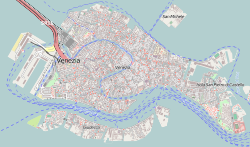This article includes a list of general references, but it lacks sufficient corresponding inline citations .(September 2020) |
You can help expand this article with text translated from the corresponding article in Italian. (November 2014)Click [show] for important translation instructions.
|
| Sant'Aponal | |
|---|---|
 Sant'Aponal facade | |
| Religion | |
| Affiliation | Roman Catholic |
| Province | Venice |
| Location | |
| Location | Venice, Italy |
| Coordinates | 45°26′17″N12°19′55″E / 45.43806°N 12.33194°E |
| Architecture | |
| Completed | 15th century |

The church of Sant'Aponal is a deconsecrated Roman Catholic church in the sestiere of San Polo in Venice, Italy.
The church was founded in the 11th century, by refugees from Ravenna and dedicated to Apollinaris of Ravenna. Restored over the centuries, it underwent major reconstruction in the 15th century. During the Napoleonic occupation, it was deconsecrated and only reconsecrated in 1851. For a time it was used as a prison for political prisoners. It was re-closed in 1984, and is now mainly an archive. The facade retains bits of Gothic architecture decoration.

